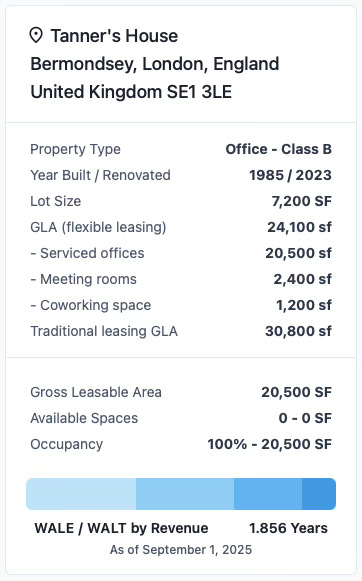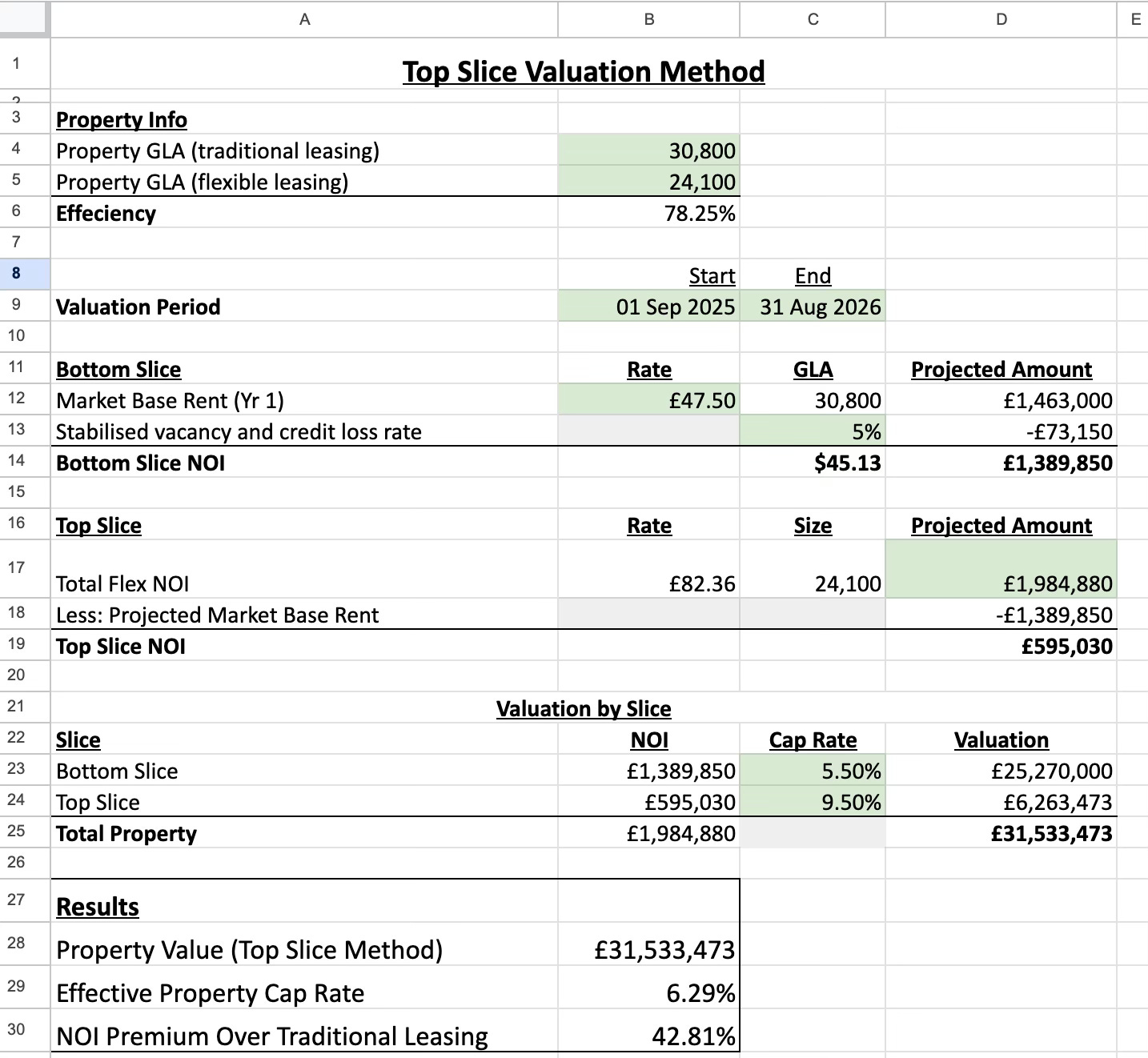Can the Top Slice Method Solve Flex Valuations?
A simple, defensible way to capture proven uplift in today’s office market
Flex income exposes a flaw in the standard playbook
Owners are proving they can outperform traditional leases—shorter commitments, higher service levels, stronger NOI. Yet when it comes to valuation, the method that dominates the industry still treats them like they’re running a conventional office block. The disconnect isn’t about the numbers—it’s about the way the income is framed.
Valuation isn’t supposed to be one-size-fits-all
The RICS Red Book recognises multiple methods—a toolbox to be applied thoughtfully. But in practice, the dominance of long leases created muscle memory: every problem started to look like a nail, so direct capitalisation became the reflexive hammer. That habit still lingers. The issue isn’t the valuer—it’s that the most common tool was designed for a different era of office leasing.
Flex has changed the game—but the method hasn’t kept up
Across the UK (and the rest of the world), owners are responding to weaker demand for long leases with smaller units, shorter commitments, turnkey fit-outs, and bundled services. The result is clear: tenants get flexibility, lower upfront CapEx, and more services—while owners earn more revenue per square foot.
It’s a win-win in theory, but when the income hits the valuer’s spreadsheet, much of that premium is treated as if it doesn’t exist. Not because valuers are blind to it—but because the dominant method struggles to capture it. That’s like trying to sew on a button with a hammer: you can force it, but it was never built for the job.
So what’s the alternative? Treat flex income on its own terms
The Top Slice method is one of the few approaches that recognises both the stability of conventional leases and the upside of flex—without breaking from accepted valuation practice. I first came across it in the work of Andrew Skinner at Savills, and it struck me because of its simplicity.
Instead of forcing all income through the same cap rate, you split the stream into slices:
the “bottom slice” — what the property could earn conventionally,
and the “top slice” — the additional NOI generated through flex.
Each slice is then capitalised at a rate that reflects its risk. The result isn’t exotic—it’s just valuation fundamentals applied with a bit more precision.
Sample Property: Tanner’s House in Bermondsey
If it were leased conventionally, the property could generate £1.390m in NOI. But converted to a flex model, it’s delivering £1.985m—a clear, stabilised uplift.
Under blunt direct capitalization, much of that £595k premium risks being flattened or ignored. The Top Slice method makes it visible:
The bottom slice (£1.390m) reflects conventional NOI, capitalised at 5.5%. → £25.3m
The top slice (£595k) reflects the flex uplift, capitalised at 9.5%. → £6.3m
Together: £31.5m.
The difference isn’t theoretical—it’s £6.3m of defensible value. And it shows exactly what’s at stake when flex performance is hit with a hammer and forced into a one-size-fits-all method.
When does Top Slice really matter?
The strength of the method is that it keeps you inside accepted practice while surfacing income that would otherwise be blurred out. But, like any tool, it works best in certain conditions.
The property is stabilised.
Top Slice isn’t designed for projections or start-ups. It assumes performance is proven and predictable, with consistent occupancy and operating results. If you’re still in ramp-up mode, you need a DCF or expected value model instead.There’s a credible fallback.
The bottom slice needs to be realistic—what the building would earn if you walked away from flex tomorrow. That doesn’t mean you need leases in place, just a defensible market rent and occupancy level. If the fallback is unrealistic—say the layout only works for flex—then the assumption needs to be adjusted, or costs to revert, factored in.The income streams can be separated.
Top Slice is powerful because it makes each slice visible. But if the NOI is blended beyond recognition, or tied to a one-off operating structure, it’s harder to apply and harder to defend.
In other words: when performance is proven, the fallback is credible, and the income streams are clear, Top Slice exposes the value that direct capitalisation leaves hidden.
Where does Top Slice really shift the conversation?
Different flex models create different challenges. The method adapts—but the common thread is that it makes visible what direct cap tends to flatten.
Owner-operators.
Cleanest use case. You control both sides of the income, so the split is obvious: the fallback (what you could earn conventionally) and the uplift (what flex is actually delivering). Direct capitalisation ignores the second half—Top Slice doesn’t.
Lease arbitrage.
Here, the building owner and operator are at arm’s length. The owner’s bottom slice is the fixed rent, valued like any long lease. The operator’s uplift becomes their own “top slice”—a spread that can be capitalised if performance is proven. That’s crucial for operators trying to raise capital: it turns invisible margin into a defensible valuation story.
Management agreements.
These often resemble retail leases with turnover rent: a base that’s below market, plus a volatile upside. Simply capitalising the minimum guarantee undersells the asset. A more defensible approach is to model the fallback as conventional NOI, then treat any share of upside as the top slice—risk-adjusted but real.
In each case, the principle is the same: flex income isn’t a nuisance to be shaved off. It’s a measurable stream, and the Top Slice method stops it disappearing in translation.
Direct cap hides the story—Top Slice makes it visible
Flex leasing is no longer fringe—it’s an in-demand and growing share of today’s office market. But the default method was designed for another era. It compresses upside into invisibility and leaves owners struggling to defend value that’s already proven in the numbers.
Top Slice doesn’t replace valuation fundamentals—it sharpens them. It separates the stable from the variable, risk-adjusts each, and adds them back together in a way that stands up to investor, lender, and auditor scrutiny.
The result: a valuation that reflects both the durability and the upside of your property. Which, at its core, is what valuation is supposed to deliver.
Want to see it in practice?
Join our live Top Slice Workshop on Wednesday 24 September at 2pm BST. We’ll walk through Tanner’s House step-by-step, show how the method applies in real scenarios, and answer your questions live.






